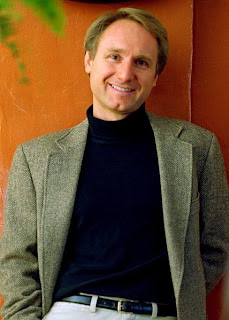Dan Brown
Dan Brown is an American author of thriller fiction. He is best known for the 2003 bestselling novel, The Da Vinci Code.Early life
He was born on June 22, 1964, in Exeter, New Hampshire, USA. He is the eldest of three children. His early life was influenced by his parents:- His father, Richard G. Brown, was a teacher of mathematics, and wrote textbooks from 1968 until his retirement in 1997.
- In Addition both of his parents are also singers and musicians, having served as church choir masters.
Secrets and Puzzles
The presenece of secrets and puzzles in Dan Brown's novels has their origine in his childhood. In fact, mathematics, music and languages were a common characteristic of his education. When he was a child, he participated in elaborate treasure hunts devised by their father on birthdays and holidays. For example on Christmas Brown and his siblings did not find gifts under the tree, but followed a treasure map with codes and clues throughout their house and even around town to find the gifts. In addition this, Brown spent a lot of time working out anagrams and crossword puzzles.Career
After dabbling with a musical career, Dan Brown started writing. He read Sidney Sheldon's novels and was influenced by his style especially in the novel The Doomsday Conspiracy. He was inspired to become a writer of thrillers and started working on Digital Fortress, setting much of it in Seville, Spain, where he had studied in 1985. His wife, with whom he co wrote a book with his wife, 187 Men to Avoid: A Guide for the Romantically Frustrated Woman, did much of the promotion of the novel when it was released.Brown subsequently wrote Deception Point and Angels & Demons, the latter of which was the first to feature the lead character, Harvard symbology expert Robert Langdon.
Brown's first three novels had little success. However, when he released The Da Vinci Code, it quickly became a bestseller, going to the top of the New York Times Best Seller list during its first week of release in 2003. It is now credited with being one of the most popular books of all time, with 81 million copies sold worldwide as of 2009.
Brown's next novel featuring Robert Langdon, The Lost Symbol, was released on September 15, 2009.It had a huge success and according to the publisher, on its first day the book sold over one million in hardcover and e-book versions in the U.S., the U.K. and Canada. The story takes place in Washington D.C. over a period of 12 hours, and features the Freemasons.
Writing habits
Recuring themes in his books include Chritianity, historical events, codes, puzzles, treasure hunts, secretive organizations and academic lectures on obscure topics.
Bibliography
- Digital Fortress, 1998
- Angels & Demons, 2000
- Deception Point, 2001
- The Da Vinci Code, 2003
- The Lost Symbol, 2009



